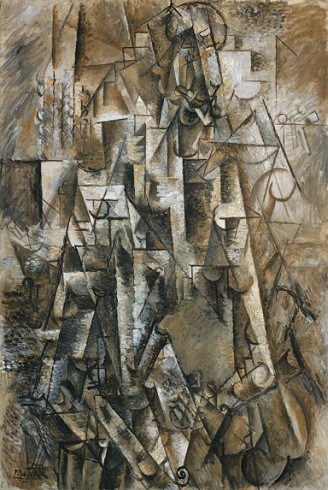All AP Art History Resources
Example Questions
Example Question #351 : 2 D Art
Each of these paintings are deconstructions of __________.
panoramas
landscapes
still lifes
portraits
portraits
Cubism, the style of art both these paintings fall under, sought to reimagine and redefine art by exploring geometric shapes and mathematical concepts. In order to reimagine the very concept of painting, cubists approached traditional styles of art in new ways. Each of these paintings is a portrait, deconstructed. The painting on the left is of a poet, (Le Poéte) by Pablo Picasso. The painting on the right is a portrait of Picasso by Juan Gris.
Figure 1: Le Poéte by Pablo Picasso (1911)
Figure 2: Portrait of Pablo Picasso by Juan Gris (1912)
Example Question #1 : Understanding Terminology That Describes Twentieth And Twenty First Century 2 D Art
Color in photographs is primarily determined by mixing the three base colors of __________.
black, green, and blue
red, white, and black
red, blue, and green
red, blue, and yellow
red, blue, and green
A color photographic negative is still black and white, and the color is only brought to the photograph in the development process. Layers of red, green, and blue all filter into particular shades of gray to determine color in traditional color photography. Thus, a photographer can imbue the photo in slightly different ways by developing a photograph in a particular manner.
Example Question #2 : Understanding Terminology That Describes Twentieth And Twenty First Century 2 D Art
"Photorealism" is a term most associated with which of the following artists?
Andy Warhol
Cindy Sherman
Robert Rauschenburg
Chuck Close
Chuck Close
Chuck Close's painting method begins with photographs, typically portraits, which he then copies onto huge, wall-size canvases. Close's intial works in the late 1960s and 1970s were extremely realistic, looking like photographs from across a room. As Close kept changing his method, he still worked from photographs, but would add more abstract painting methods to produce his images.
Example Question #281 : Renaissance To Contemporary 2 D Art
"Drip painting" is the approach to painting in which __________.
the paint is applied so thickly as to give a three-dimensional effect
large blocks of color are painted across the canvas
a glossy finish is applied at the end of the painting to give the work a wet look
paint is allowed to fall on the canvas from a vertical position
paint is allowed to fall on the canvas from a vertical position
Drip painting is most closely associated with the twentieth-century American painter Jackson Pollock, whose signature works involved Pollock splattering, splashing, and slowly dripping paint directly onto canvasses that were laid on the ground. The technique was used almost contemporaneously by the artist Janet Sobel, and has been consistently used by a small cadre of artists from the 1950s to the present.
Example Question #4 : Understanding Terminology That Describes Twentieth And Twenty First Century 2 D Art
The "Zone System," formalized by photographer Ansel Adams in the early twentieth century, established __________.
the proper method for framing a photograph before taking the image
the principles for developing film to achieve optimal light and focus in a photograph
the formulation for use in balancing the color in a color photograph
the theory for the use of photography instead of painting
the principles for developing film to achieve optimal light and focus in a photograph
Ansel Adams is well known for two related things: his sweeping black and white photographs of the American West and his many books and classes teaching photography. Most significant in relation to the latter is his development of the "Zone System." The Zone System set down specific parameters to achieve the optimal light, focus, and composition in the development of the film.
Example Question #21 : Twentieth And Twenty First Century 2 D Art
The loosely defined group of painters known as the "Ashcan School" were largely united in their use of __________.
dramatic historical episodes
pop culture phenomena
realistic street scenes
themes from classical mythology
realistic street scenes
The "Ashcan School" referred to a loosely connected group of artists in the early twentieth century in Philadelphia and New York. John Sloan, Everett Henri, and George Luks were among the prominent artists associated with the movement. The movement, while fairly loosely associated, was largely united through a devotion to presenting scenes of urban life in a gritty, realistic manner.
Example Question #22 : Twentieth And Twenty First Century 2 D Art
Which of the following techniques was used by Andy Warhol to create the multiple images making up his Marilyn Diptych?
Woodcut
Etching
Silk-screening
Mimeographing
Silk-screening
The Marilyn Diptych was created shortly after Marilyn Monroe's death in 1962. In order to create the work, Andy Warhol used only one publicity still of the actress, and repeated the image fifty times. Warhol used silk-screening, a process where a wooden stencil pushes ink-covered mesh onto a medium, to repeat the image. The left side of the diptych is painted over in bright, pastel colors, while the right side features only black and white images of the actress.
Example Question #23 : Twentieth And Twenty First Century 2 D Art
Which of the following artists is NOT generally considered an abstract expressionist?
Willem de Kooning
Jackson Pollock
Edward Hopper
Clyfford Still
Edward Hopper
The abstract expressionists were a group of artists in post-World War II New York City who created large canvases of abstract forms with a focus on emotional elements. The artists actually used a variety of styles and approaches, from Jackson Pollack's drip paintings to the figural shapes of Willem de Kooning and Paul Klee and the color forms of Clyfford Still and Mark Rothko. The use of abstract painting was a profound departure in American art, in particular from the significant realism of artists such as Edward Hopper.
Example Question #24 : Twentieth And Twenty First Century 2 D Art
The use of Ben-Day Dots, a technique adapted from the coloring of comic books, was a hallmark of which Pop Artist?
Andy Warhol
Robert Rauschenberg
Roy Lichtenstein
Jasper Johns
Roy Lichtenstein
Roy Lichtenstein became famous in the 1960s through a series of large canvasses that were directly copied from comic books. Using comic book images as inspiration, Lichtenstein also applied a technique known as Ben-Day Dots, the stenciling of small dots that colored comic books in the era. Lichtenstein would continue to use the technique in his later career, when he was no longer directly adapting images from comic books.
Example Question #23 : Twentieth And Twenty First Century 2 D Art
A work of art that is a compilation of various images put together in one piece is known as a __________.
mosaic
mural
collage
fresco
cast
collage
A collage is constructed not as one image, but by compiling a variety of images into one larger piece. This can be done for a variety of reasons, including ironic juxtaposition, social commentary, or refreshing traditional imagery. Collages became more widely used in the twentieth century as various forms of media were brought into widespread use.
All AP Art History Resources






